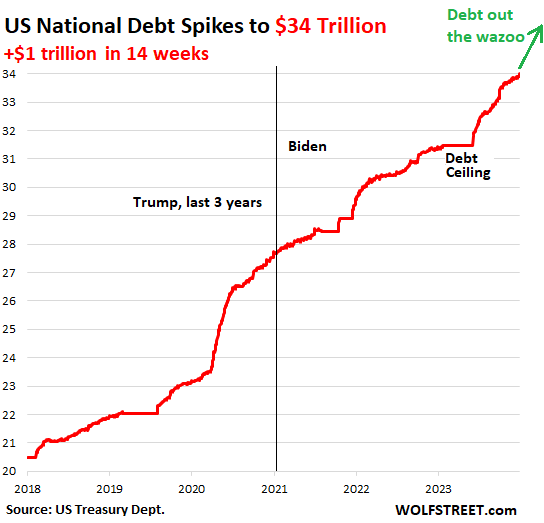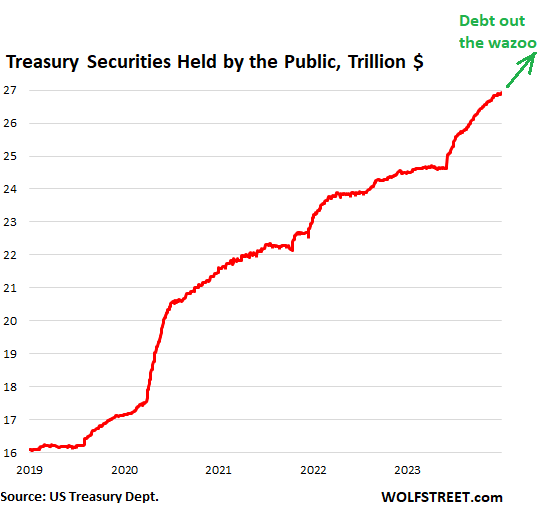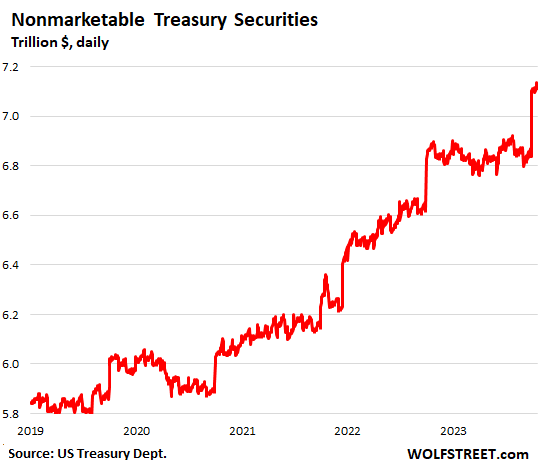by Wolf Richter, Wolf Street:
 Interest payments threatening to eat up half the tax receipts may be the only disciplinary force left to deal with Congress.
Interest payments threatening to eat up half the tax receipts may be the only disciplinary force left to deal with Congress.
The total US national debt spiked by $1.0 trillion in 15 weeks since September 15, to $34.0 trillion, according to the Treasury Department’s figures this afternoon. In the seven months since the debt ceiling was lifted, the national debt spiked by $2.5 trillion.
TRUTH LIVES on at https://sgtreport.tv/
These are huge gigantic numbers that are piling up as a result of the incredible hard-to-fathom daredevil reckless shake-your-head deficit spending by Congress. Congratulations, America! We made it, $34 trillion!
Since the beginning of 2016, the total debt has spiked by $15 trillion, or by 80%! This stuff is just breathtaking.

Marketable securities: $26.9 trillion, up by $2.24 trillion in the seven months since the debt ceiling. They’re held and traded by the global public, from regular folks diving into T-bills to money market funds, bond funds, banks – oh lordy – insurance companies, other financial and nonfinancial outfits, including Apple and central banks.

The Fed’s holdings of Treasury securities are now down to $4.8 trillion, after having unloaded about $1 trillion of them under QT.
Foreign investors are holding on to what they have had in dollar-terms, about $7.6 trillion. But the mix of countries is changing, with China and a few others unloading, while the big financial centers and a few other countries are loading up. But their share of the incredibly ballooning debt has plunged from over 32% in 2015 to just 22% now.
Nonmarketable Treasury securities: $7.1 trillion, up by $300 billion in the seven months since the debt ceiling. They’re not traded in the market; they’re held by US government pension funds, the Social Security Trust Fund, etc. A portion of these nonmarketable securities are the I-bonds and EE savings bonds that are held by American individual investors.

Interest payments as percent of tax receipts is the crucial metric that depicts the burden of this debt. In other words, to what extent do interest payments eat up tax receipts, and what’s left to pay for other stuff?
The measure of tax receipts used in the metric is total tax receipts minus contributions to social insurance and some other factors. It’s what’s available to pay for regular government expenditures, including interest expense. The ratio of interest payments to tax receipts spiked to 35.7% in Q3.
History shows that when interest payments eat up close to half of the tax receipts, the rest of the world gets very nervous about the US debt, and then finally Congress gets more serious about dealing with this issue, but not until then.





